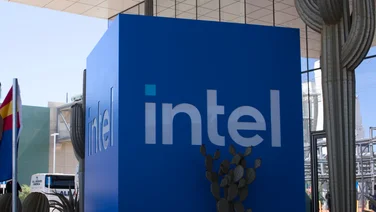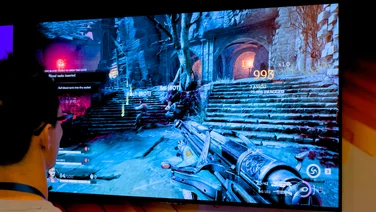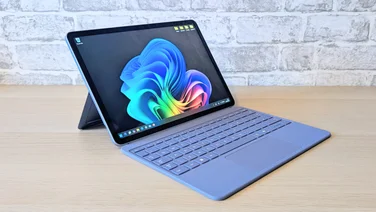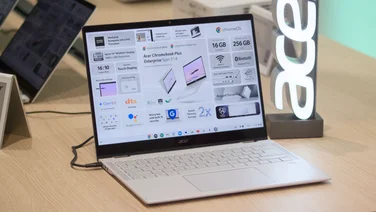To help us provide you with free impartial advice, we may earn a commission if you buy through links on our site. Learn more
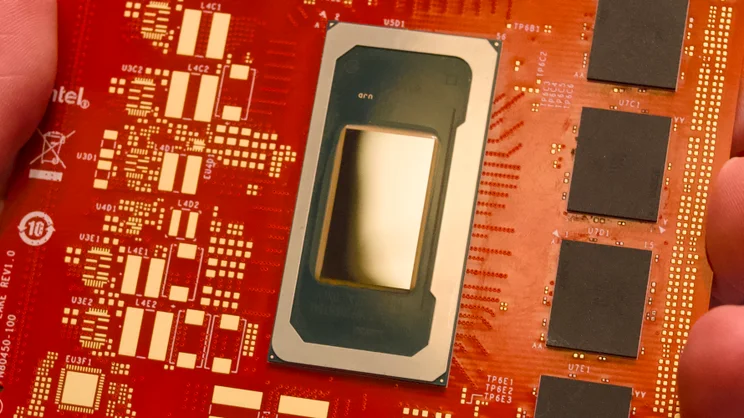
While most of the events I attend in the course of my job tend to focus on complete products – laptops, smartphones, monitors and the like – it’s always good to find out more about the components that power so many of them, dig into the details and find out what makes them tick.
That’s what I spent a couple of days doing at the Intel Technology Tour 2025 last week: being bombarded with details about Panther Lake, the chip that’s set to power Intel’s next generation of super-efficient laptops – and, after a turbulent few years, the thing that could put Intel back on top.
For a long time, certainly for laptops, Intel was king. That status has been eroded in recent times, but the firm struck back with its Core Ultra Series 2 chips last year (aka Lunar Lake), finally catching up with the likes of Apple and, more recently, Qualcomm, on efficiency and battery life.
Its Lunar Lake-powered laptops have been a bit of a revelation – I’ve enjoyed seeing products like the Dell Pro 13 Premium, the HP EliteBook X Flip G1i and the Asus ZenBook S 14 (UX5406S) streak past the previously impervious Apple MacBook Air. More recently, Arrow Lake-powered machines from the likes of Honor with its MagicBook Pro 14 have grabbed the baton and run even faster, with greater CPU and GPU grunt.
Intel 18A
The next step along the way is Intel Core Ultra series 3 (code-named Panther Lake) and it could be Intel’s most important mobile processor in years, thanks to one major development: the so-called 18A manufacturing process. This, as the name suggests, is a 1.8nm process – and Panther Lake is the first officially launched 2nm processor we’ve yet seen.
Other manufacturers are working on their own versions of 2nm technology, namely TSMC and Samsung, but it looks like Intel has got there first, with the new fabs in Oregon and Phoenix, Arizona already producing chips at volume, and products from laptop manufacturers set to appear in early 2026. Expect a raft of announcements at CES 2026 in Las Vegas.
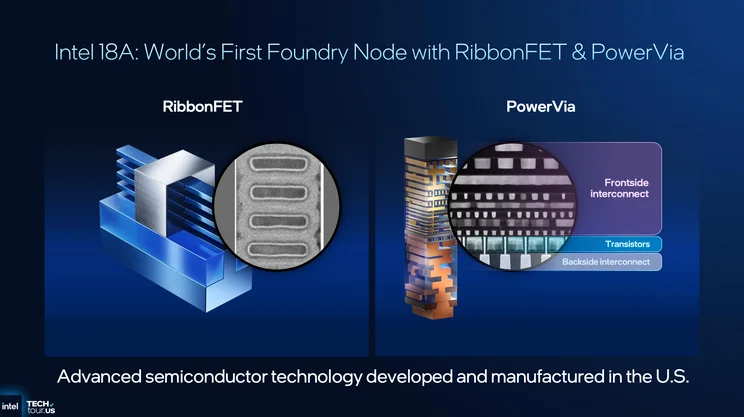
It’s not just about the size of the transistors, though. Intel’s 18A process also brings a new type of transistor – the RibbonFET – and a new way to provide power to those tiny electrical components – PowerVIA. The RibbonFET is smaller than the previous FinFET transistor, which the company has been using in its CPUs for more than a decade, and works faster, too. It’s PowerVIA, however, that could prove to be the biggest step forward.
Where previously, power connections and transistors were all mounted on the front of the die, PowerVIA sees them shifted to the rear. This frees up space, allowing even more transistors to be squeezed onto the front. Intel says the technology can lead to reduced power consumption and that Holy Grail – greater battery life.
More cores, more performance per Watt
Just like previous Core Ultra chips, Panther Lake is built around a system of “chiplets”; instead of one homogenous die, the chip is made up from lots of “tiles”, all mounted together in a single package. Here, however, the arrangement is slightly different from previous chips.
On Panther Lake, the tiles are arranged into three: CPU, GPU, and platform controller tile – one more than Lunar Lake, one fewer than Meteor Lake – and with only the CPU tile using the 18A technology. There’s no on-package memory, as with Lunar Lake, fortunately, but external memory support isn’t quite as extensive as Arrow lake, with a maximum 128GB of DDR5 memory or 96GB of LPDDR5.
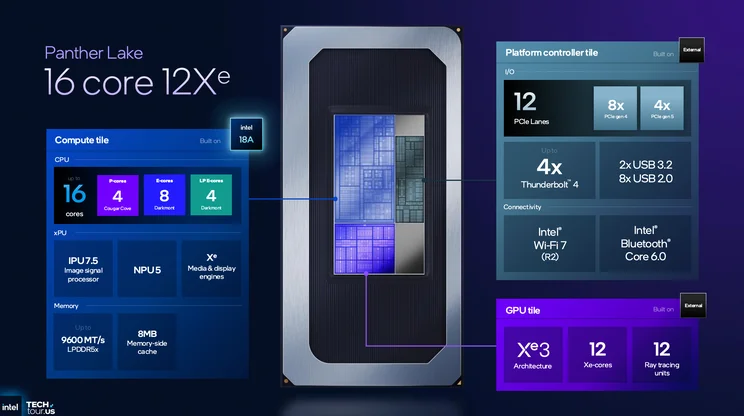
The CPU tile is the powerhouse of this set up, however, and at its heart lies two brand new cores: the new Cougar Cove P-core (performance) and the Darkmont E- and LPE-cores (efficiency and lower power efficiency). Initially, three variants of the Panther Lake chip will be available to laptop manufacturers, with different arrangements of these cores.
The most powerful will come with 16 total CPU cores – 4P, 8E and 4 LPE – and 12 Xe3 graphics cores. The next model down in the range has the same 16 CPU cores but with only 4 Xe3 graphics cores. I imagine this will be the chip you’ll see in laptops powered by third-party GPUs. Finally, at the bottom end, is an 8-core chip with 4 Cougar Cove P cores and 4 low power Darkmont E-cores.
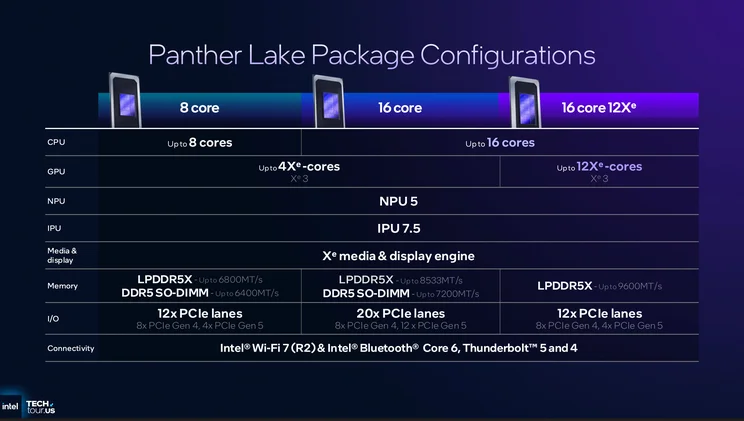
Intel Panther Lake performance claims
So what does this mean for performance and battery life? Obviously, we won’t know how the new chip will pan out in the real world until we get our hands on review samples. In the meantime, here are Intel’s numbers.
It is claiming greater than 10% better single-threaded performance versus Lunar Lake and more than 50% better multi-threaded performance versus Lunar Lake and Arrow Lake. It says that Panther Lake consumes more than 30% less power than Arrow Lake at similar multi-threaded performance levels.
It is also claiming lower power consumption across the rest of the CPU’s functions: up to 1.5W lower power consumption for HDR video playback using a technique it is calling “staggered HDR”; and up to 40% lower power consumption on SoC functions versus Arrow Lake.
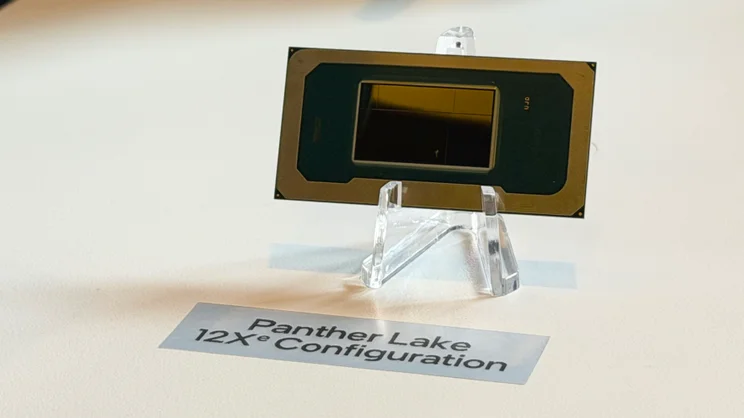
It’s sometimes more instructive with manufacturers’ numbers to look at what they are not saying, instead of taking the numbers at face value. Here it’s worth noting that Intel didn’t say single threaded performance would be better than Arrow Lake and it didn’t say that Panther Lake consumes less power than Lunar Lake for multi-threaded tasks.
However, the overall picture that emerges is positive. Panther Lake looks set to be more powerful than Lunar Lake and at least as power efficient, and more powerful than Arrow Lake in general, too.
Intel Xe3 promises faster, more capable integrated graphics
There’s no Intel Arc-branded graphics in Panther Lake, but we do get the latest generation of Xe integrated graphics. That’s Xe3, and there’s plenty of interesting stuff going on here. First of all, Intel says each of the Xe cores are more capable, with 33% more L1 cache, larger Ray Tracing units and the ability to process more vector threads.
More important than this, however, is that the top-end Panther Lake chip will be available with not eight but 12 Xe cores, delivering more raw performance – up to 50% faster than the fastest Lunar Lake chip, according to Intel. The lower end variants, however, will only have four cores and are less likely to deliver the sorts of chunky improvements you might expect.
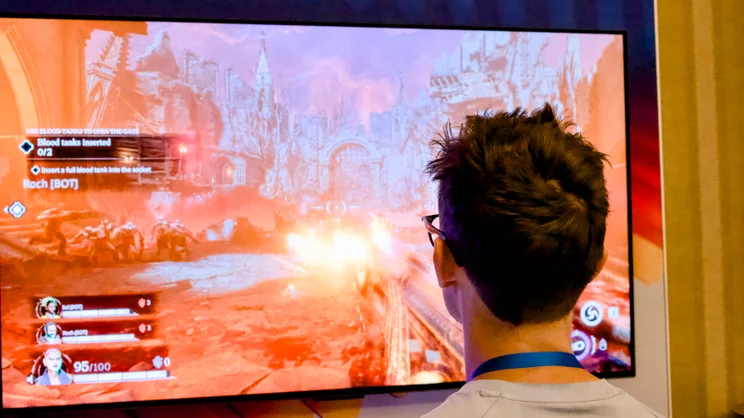
Naturally, AI will also have a part to play in making Panther Lake laptops AAA gaming capable and that comes courtesy of Intel’s XeSS 2 technology, which uses super multi-frame generation technology to add up to three AI-generated frames for every one traditionally rendered frame, upping the apparent frame rate by 4x.
During one of the demonstrations, Intel showed off a new FPS game called PainKiller (releasing on 21 October) at 1080p on the 12Xe core Panther Lake chip, running at 200fps courtesy of the new technology. I also had the chance to try this out in person in the demo zone later. It’s impressive, but the technology does introduce a fair degree of perceptible input lag, so it may not be for everyone.
NPU and IO
After taking a step backwards with the rather underpowered NPU in its Arrow Lake chips, Intel is back with a more powerful version this time around. But while it quotes the overall system TOPS (trillions of operations per second) at an impressive 180, the NPU 5 is only at 50 TOPS in Panther Lake.
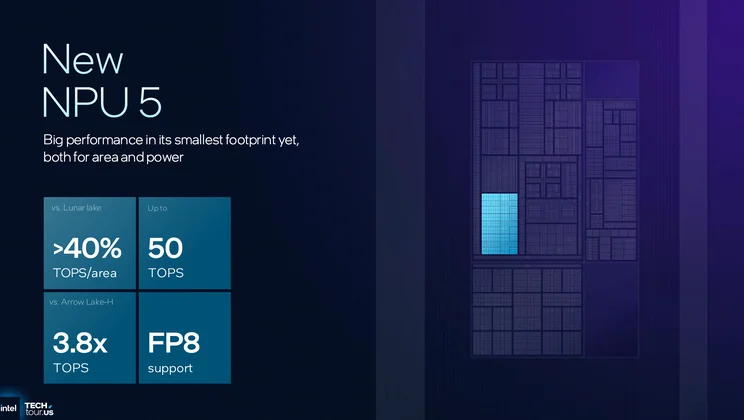
That might sound unimpressive but Intel has clearly been working on other factors, one of which is reducing the amount of real estate the NPU occupies within the chip. On this front, it seems it has succeeded, with 18A helping it squeeze in 40% more TOPS per area than Intel NPU 4, although the number of compute engines has fallen to three from six.
Other capabilities such as the ability to process 8-bit floating point numbers natively and MAC array that’s twice the size as before, look set to improve the efficiency of the chip.
Elsewhere, there’s support for Thunderbolt 4 (but not Thunderbolt 5, oddly), Wi-Fi 7 and, intriguingly, dual Bluetooth 6 on-chip.
Intel Panther Lake: Final thoughts
Intel clearly has plenty riding on the launch of Panther Lake, specifically its homegrown 18A technology. Building this sort of manufacturing capacity is an expensive business – a multi-billion dollar leap of faith, if you will – and the success or otherwise of its CPUs will determine whether Intel can compete on a level playing field with the likes of TSMC and Samsung in the coming years.
It has taken Intel four years since first breaking ground on its 18A fabrication facility at its Ocotillo plant near Phoenix, Arizona and it says this type of capability typically costs between $20 and $25 billion. With another 18A fab at the company’s site in Oregon, there’s an awful lot of investment riding on it.
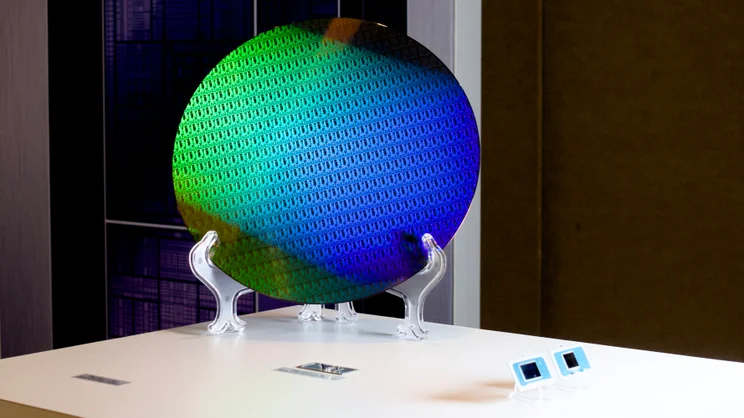
For now, though, it certainly looks promising. Panther Lake looks set to not only deliver the power efficiency and performance levels of Lunar Lake and Arrow Lake in one new chip, but improve on both counts as well. And Intel also has its beefy Clearwater Forest server chip in the wings, too, which doubles the core count to 288 Darkmont E-cores, compared with its predecessor’s (Xeon 6, aka Sierra Forest) 144 Crestmont cores.
I suspect that, despite all the investment and years of planning, the days of Intel dominating the CPU industry are gone never to return, but with 18A and Panther Lake, the signs are that it can at least hold onto a healthy chunk of the mobile computing market place. Obviously, though, the proof of this particular CPU pudding will be in the eating – or rather the benchmarking. We await the first Panther Lake laptops with bated breath.



